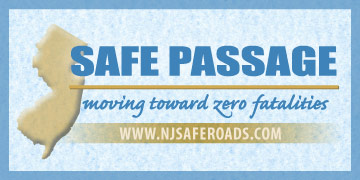 |
 |
|
 |
|
|
 |
|
|
 |
 |
 |
| |
About
Us |
|
 |
 |
 |
| |
 |
 |
| |
The
mission of the Division of Highway Traffic Safety is
the Safe Passage of all roadway users in New Jersey
as we move toward zero fatalities. To achieve our mission,
the Division promotes statewide traffic safety programs
through education, engineering and enforcement activities. |
|
 |
| |
The bulk of the Division's funding comes from the Federal
Government, through the National Highway Traffic Safety
Administration. The funding received by the Division
is used to undertake state-wide traffic safety programs
and is also dispersed to municipal, county, state government
and law enforcement agencies, as well as non-profit
organizations in the form of traffic safety grants.
|
|
 |
| |
The
Director is appointed by the Governor and also serves
as the Governor’s Representative for highway safety. |
|
 |
| |
Traffic
safety priority areas that the Division attempts to
address include: |
|
 |
| |
 |
Occupant Protection:
Issues relating to the use of seat belts and child
safety seats. |
|
 |
| |
 |
Impaired
Driving:
Efforts to reduce driving while impaired by drugs or
alcohol. |
|
 |
| |
 |
Pedestrian/Bicycle
Safety:
Programs designed to reduce crashes involving pedestrians
or bicycles. |
|
 |
| |
 |
Diversity
Programs:
Bringing the traffic safety message to the state’s
diverse populations. |
|
 |
| |
 |
Comprehensive
Traffic Safety Programs:
County-wide programs that address specific traffic safety
issues in a particular county. |
|
 |
| |
 |
Distracted
Driving:
Educating motorists about the dangers of distractions
such as talking on a cell phone or sending text messages
while driving. |
|
 |
| |
 |
Aggressive
Driving:
Reducing dangerous driving practices including speeding,
excessive lane changes, tailgating and gesturing. |
|
 |
| |
 |
Young
Drivers:
Raise awareness among young drivers and passengers of
the dangers of impaired driving, speeding and not wearing
seat belts. |
|
 |
| |
 |
Older
Drivers:
Promote programs directed towards reducing traffic-related
injuries and fatalities among older people. |
|
 |
| |
 |
Emergency
Medical Services:
Ensure persons incurring traffic related injuries receive
prompt emergency medical care. |
|
 |
| |
 |
Traffic
Records:
Provide a complete and useful records system at the
state and local level. |
|
 |
| |
 |
Work
Zone Safety:
Develop and implement systems and procedures for carrying
out roadway construction and operations in a safe manner. |
|
 |
| |
 |
Motorcycle
Safety:
Promote motorcycle safety by addressing the use of helmets,
impaired riding, rider training and motorist awareness. |
|